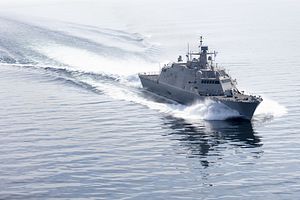The latest Freedom-class littoral combat ship (LCS), the future USS Indianapolis, successfully completed acceptance trials on Lake Michigan on June 26, according to a Lockheed Martin statement.
Acceptance trials, the last major step before delivering the LCS to the U.S. Navy, are conducted by the service’s Board of Inspection and Survey, the U.S. Navy’s chief body inspecting and reporting on a warship’s readiness for active duty operations.
“The trials included a full-power run, maneuverability testing, and surface and air detect-to-engage demonstrations of the ship’s combat system,” according to the company statement. “Major systems and features were demonstrated, including aviation support, small boat launch handling and recovery and machinery control and automation.”
The new LCS was christened in April 2018 at the Fincantieri Marinette Marine (FMM) shipyard in Marinette, Wisconsin. Following the ship’s delivery, the Indianapolis is slated to be commissioned by the U.S. Navy in October 2019.
“LCS 17 is joining the second-largest class of ships in the U.S. Navy fleet, and we are proud to get the newest Littoral Combat Ship one step closer to delivery,” said Joe DePietro, Lockheed Martin vice president and general manager, Small Combatants and Ship Systems.
The LCS class consists of the Independence and Freedom variants. Construction of the Freedom variant is led by Lockheed Martin at FMM. The construction of the Independence class is headed by Austal USA in Mobile, Alabama. The Austal and Lockheed Martin shipyards are each capable of building two LCSs per year. Lockheed Martin has delivered a total of eight LCSs to the U.S. Navy to date.
As my colleague Steven Stashwick reported in May, Lockheed Martin is also leading an effort to boost the combat capabilities of both LCS variants in a two-phased plan.
As I noted previously:
[W]ith 40 percent of the hull reconfigurable, both LCS variants use an open architecture design, enabling the warships to be fitted with interchangeable so-called mission packages providing capabilities for surface warfare (SUW), anti-submarine warfare (ASW), and mine countermeasures (MCM) missions in the littoral zone. The ASW warfare package is expected to become available to the fleet in 2019, while the MCM package will be available in 2020.
The U.S. Navy also completed structural testing of the Surface-to-Surface Missile Module (SSMM), part of the SUW mission package, earlier this month. The SSMM, a 24-shot vertical launch system designed to engage surface targets with AGM-114L Longbow Hellfire missiles, will be installed on all LCSs.
“Delays in the development of the SSMM led to the initial deployment of a more limited surface warfare [SUW] mission package aboard the LCS, exchanging Hellfire Missiles for rigid hull inflatable boats and boarding teams,” I wrote in 2017. “The package also encompasses two 30-millimeter machine guns, two MQ-8B Fire Scout unmanned aerial vehicles, and an MH-60S Seahawk helicopter.”
Besides the various packages, standard armament of a Freedom-class LCS includes a 11-cell Raytheon RIM-116B SeaRAM missile-defense system, a 57-millimeter naval gun, and Mark 5o torpedoes.
The U.S. Navy launched the future USS Minneapolis-Saint Paul (LCS 21) during a ceremony at FMM on June 15.

































